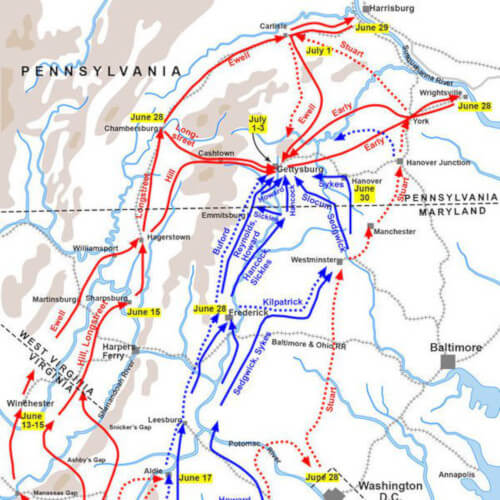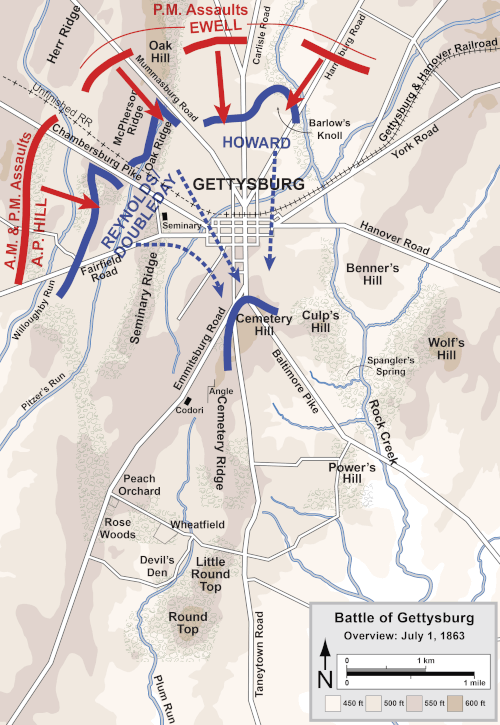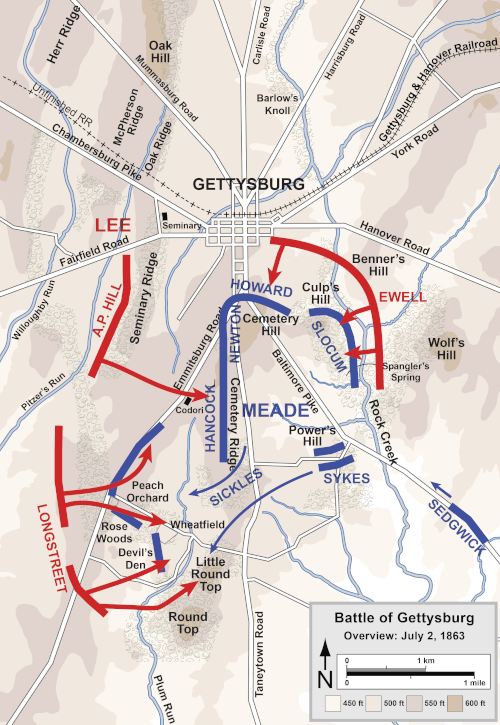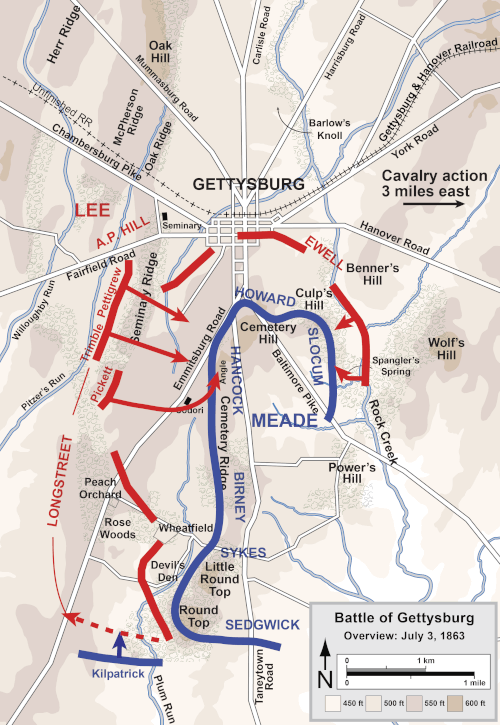Civil War Battles and Engagements
Exploring various battles and skirmishes of the Civil WarThe Battle of Gettysburg
After Confederate General Robert E. Lee’s success at Chancellorsville in May 1863, he made the decision to imnvade the North so as to shift the focus of the war from Virginia while attempting to influence Northern politicians to end the war. This second invasion of the North would become known as the Gettysburg Campaign. The Battle of Gettysburg took place in and around Gettysburg, Pennsylvania, from July 1 to July 3, 1863. With approximately 160,000 troops engaged, this battle is considered the largest during the American Civil War.
Prelude to the Battle
After defeating the Union forces of Gen. Joseph Hooker at Chancellorsville, Virginia, in May, Confederate Gen. Robert E. Lee decided to invade the North in hopes of further discouraging the enemy and possibly inducing European countries to recognize the Confederacy. Confederate morale was high while defeatist sentiment was spreading in the North, and Lee’s army numbered more than 71,000 troops.
In preparation for his invasion, Lee reorganized his army into three corps under Gen. A.P. Hill, Gen. James Longstreet, and Gen. Richard S. Ewell. The cavalry was led by Gen. Jeb Stuart. During the last week in June 1863, Stuart made a bold and possibly ill-advised cavalry sweep completely around the Federal forces, passing between them and Washington, D.C. On June 28, when his Army of Northern Virginia was extended deep into Pennsylvania, Lee was out of touch with his cavalry under Stuart, which should have served as the eyes of the army.
Through a spy, Lee received a report that Hooker’s Army of the Potomac was at Frederick, Maryland, under a new commander, Gen. George G. Meade, who had just replaced Hooker. Lee took immediate steps to meet this unexpected threat. Ewell, whose corps had been preparing to carry the offensive across the Susquehanna from positions at Carlisle and York, was ordered to move either to Cashtown or Gettysburg. Longstreet’s corps at Chambersburg and Hill’s corps at Greenwood, both of which had been preparing to move north, were to march east to Cashtown. This concentration east of South Mountain would put Lee in an excellent strategic position to defend or attack.
Early on June 29 Meade started north with Gen. John Buford’s two cavalry brigades scouting ahead of the army. While maneuvering to keep between Lee and the Federal capital, Meade intended to make Lee turn and fight before he could cross the Susquehanna. On June 30 Buford’s troopers met and drove back a Confederate brigade from Hill’s corps that was approaching Gettysburg. Hill then authorized Gen. Henry Heth to lead his division into Gettysburg the next day. Buford, meanwhile, had immediately recognized the strategic importance of Gettysburg as a crossroads and prepared to hold the town until reinforcements arrived.
July 1, 1863
On July 1 one of Buford’s brigades, armed with the newly issued Spencer repeating carbines, delayed Heth’s division until Gen. John F. Reynolds’s I Corps began to arrive at about 11:00 AM. A vigorous counterattack drove Heth’s two leading brigades back with heavy losses on both sides. Reynolds was mortally wounded in the engagement; he would be the highest-ranking officer to die at Gettysburg and one of the most senior commanders to be killed in action during the war.
By 1:00 PM all three divisions of the I Corps were deployed along Seminary Ridge, and two divisions of Gen. Oliver O. Howard’s XI Corps had arrived to defend the northern approaches to the town. A third division of the XI Corps was posted on Cemetery Hill. Howard reached the field about noon, turning his XI Corps over to Gen. Carl Schurz and succeeding Gen. Abner Doubleday in overall command of the battlefield. The Federals resisted on both fronts until about 2:30, but an attack by Gen. Jubal Early’s division against the northeast flank of the XI Corps led to collapse of their entire position. The XI Corps was routed, exposing the flank of the I Corps and forcing it to retreat. Before the defenders could rally on Cemetery Hill, the two Union corps had sustained more than 50 percent casualties. Lee now had superior strength available, but, being in the dark as to the enemy’s true dispositions, he did not want to bring on a general engagement until Longstreet’s corps arrived.
About 4:00 PM Gen. Winfield Scott Hancock arrived to examine the situation for Meade and decide whether to drop back to previously prepared positions along Pipe Creek, some 15 miles (24 km) southeast. After recognizing the importance of Culp’s Hill and ordering that it be occupied, Hancock studied the terrain and reported that Gettysburg was the place to fight. Having reached the same conclusion, Meade had already ordered the III Corps (under Gen. Daniel Sickles) and the XII Corps (under Gen. Henry Slocum) forward. Lee told Ewell to attack Cemetery Hill “if possible,” but Ewell did not elect to take the risk. By the end of the first day, total casualties already amounted to some 15,500 killed, wounded, captured, or missing.
July 2, 1863
By dawn Meade’s troops had occupied a line along Culp’s Hill, Cemetery Hill, and Cemetery Ridge. Both opposing commanders recognized that a Confederate success on the Federal right would jeopardize Meade’s position by threatening his line of communication along the Baltimore Pike. Lee wanted to exploit this strategic weakness, but Ewell argued that Longstreet should make the main attack on the opposite flank. Longstreet, on the other hand, contended that Lee should make Meade attack.
Delayed by the opposition of his corps commanders, Lee did not issue his orders until 11:00 AM. Longstreet was to envelop the Federal south flank and attack north along the Emmitsburg Pike, where Lee erroneously believed Meade’s main line to be. Hill and Ewell were to make secondary attacks. When Longstreet’s artillery started preparatory firing at 3:00 PM, Meade rushed to the heretofore neglected south flank and found that Sickles had not positioned his III Corps along Cemetery Ridge as directed but had moved forward to higher ground. This created a dangerous salient and weakened the south flank, but it was too late to pull him back. Gen. John Bell Hood’s division of Longstreet’s corps attacked the Union left at 4:00 PM.
About this time Gen. Gouverneur K. Warren, Meade’s chief engineer, had reached Little Round Top and found it undefended. Before the 500 Alabama troops who had scaled Big Round Top could continue their attack from that hill, Warren had diverted sufficient Federal reserves to defend Little Round Top. While Warren’s action secured the main battle position, the Federal III Corps was driven from “Sickles’s salient” with crippling losses. There was desperate fighting at Little Round Top, Devil’s Den, the Wheat Field, and the Peach Orchard. Both Hood and Sickles were seriously wounded. Confederate secondary attacks were so poorly timed, however, that Meade could shift strength from quiet parts of his line and move reserves to meet each new threat. Hill attacked too late to achieve significant results, and not until 6:00 PM did Ewell launch the assault that should have begun hours earlier to coincide with Longstreet’s. Some of Ewell’s troops reached Cemetery Hill but were driven off, while others were stopped on the southeast slopes of Culp’s Hill. Casualties on the second day numbered some 20,000 killed, captured, wounded, or missing; taken by itself, the second day of Gettysburg ranks as the 10th bloodiest battle of the entire war.
July 3, 1863
In spite of Longstreet’s objections, Lee was determined to attack again on the third day. Meade, on the other hand, was less confident, and it was only after a formal council of war that he decided to stay and fight. While Ewell made a secondary attack against Culp’s Hill, Lee planned to hit the Federal centre with 10 brigades, three of which were the fresh troops of Gen. George Pickett’s division. Although this attack has been immortalized as “Pickett’s Charge,” that general’s only overall responsibility was to form the divisions of Brig. Gen. James Johnston Pettigrew (who had assumed command of Heth’s division after Heth was wounded on July 1) and Gen. Isaac Trimble (who had taken over Gen. Dorsey Pender’s division after Pender was mortally wounded on July 2) as they reached their attack positions on his left. Longstreet, not Pickett, was in command of the operation. Shortly after 1:00 PM the Confederates started a tremendous artillery bombardment, which was answered immediately by Federal counterfire.
At 3:00 PM the infantry moved out of the woods in parade ground order and started across the 1,400 yards (1,280 metres) of open fields toward Cemetery Ridge. The Federals watched in awed silence as some 15,000 Confederate troops moved toward them. Then the Federal artillery, which had ceased fire an hour earlier to save ammunition, went back into action with devastating effect at a range of about 700 yards (640 metres). Almost unscathed by the Confederate artillery preparation, most of which had gone over their heads, the roughly10,000 Federal infantry against whom the attack was directed waited coolly behind stone walls and held their fire until the Confederates were within effective range. The southern spearhead broke through and penetrated onto Cemetery Ridge, but there it could do no more. Critically weakened by artillery during their approach, formations hopelessly tangled, lacking reinforcement, and under savage attack from three sides, they marked “the high tide of the Confederacy” with the bodies of their dead and wounded. Leaving 19 battle flags and hundreds of prisoners, the Confederates retreated, demoralized but without panic. Part of one Union brigade advanced to hasten their retreat, but the Army of the Potomac had been too roughly handled to mount a counterattack.
Early in the day, Ewell had attacked Culp’s Hill without success. Stuart, whose bone-tired brigades had arrived the previous evening, was driven back by three Federal cavalry brigades when he tried to envelop Meade’s strategic north flank. At the other end of the lines, Federal cavalry was foolishly employed in futile and costly charges across rough terrain against Hood’s infantry.
Lee waited during July 4 to meet an attack on Seminary Ridge that never came. That night, taking advantage of a heavy rain, he started retreating to Virginia through the South Mountain passes. Lee was held up at Williamsport for a week waiting for the Potomac River to run down, but on the night of July 13 he withdrew his army and trains into the Shenandoah Valley before Meade, who had appeared on his front the day before, could launch an attack.
Key Players in the Battle of Gettysburg
George Gordon Meade
Meade was a career United States Army officer and civil engineer best known for decisively defeating Confederate General Robert E. Lee at the Battle of Gettysburg in the American Civil War. He previously fought with distinction in the Second Seminole War and the Mexican–American War
Robert E. Lee
Robert Edward Lee was an American and Confederate soldier, best known as a commander of the Confederate States Army. He commanded the Army of Northern Virginia in the American Civil War from 1862 until its surrender in 1865.
Joshua Lawrence Chamberlain
Joshua Lawrence Chamberlain was an American college professor from the State of Maine who volunteered during the American Civil War to join the Union Army. He became a highly respected and decorated Union officer, reaching the rank of brigadier general.
James Longstreet
James Longstreet was one of the foremost Confederate generals of the American Civil War and the principal subordinate to General Robert E. Lee, who called him his “Old War Horse”.
Learn More
Videos
Vocabulary
Brigade – A large group of soldiers, commanded by a brigadier general. Brigades consisted of 4 – 6 regiments.
Company – Small groups of soldiers within regiments which numbered 50 -100 men. Ten companies comprised each regiment.
Division – Another means by which the Union and Confederate armies provided structure and organization to large bodies of troops. Divisions consisted of 2 – 5 brigades.
Flank – A flank is the end (or side) of an army’s position. Used as a verb, “to flank” is to move around and attack the side of an enemy’s position, to avoid a frontal attack.
Little Round Top – The smaller of two rocky hills which sits south along Cemetery Ridge.
McPherson’s Ridge – Ridgeline west of Gettysburg along which Cavalry General John Buford positioned his dismounted cavalry in an attempt to prevent the Confederates from taking the town of Gettysburg and advantageous topography which surrounded it.
Pickett’s Charge – named after Major General George Pickett, one of three Confederate generals who led the charge against Union General George Meade on July 3, 1863, the last day of the Battle of Gettysburg
Seminary Ridge – Ridgeline southwest of the town of Gettysburg along which the Army of Northern Virginia positioned itself after July 1st. Seminary Ridge served as the point from which all Confederate attacks were launched on July 2nd – 3 rd .




